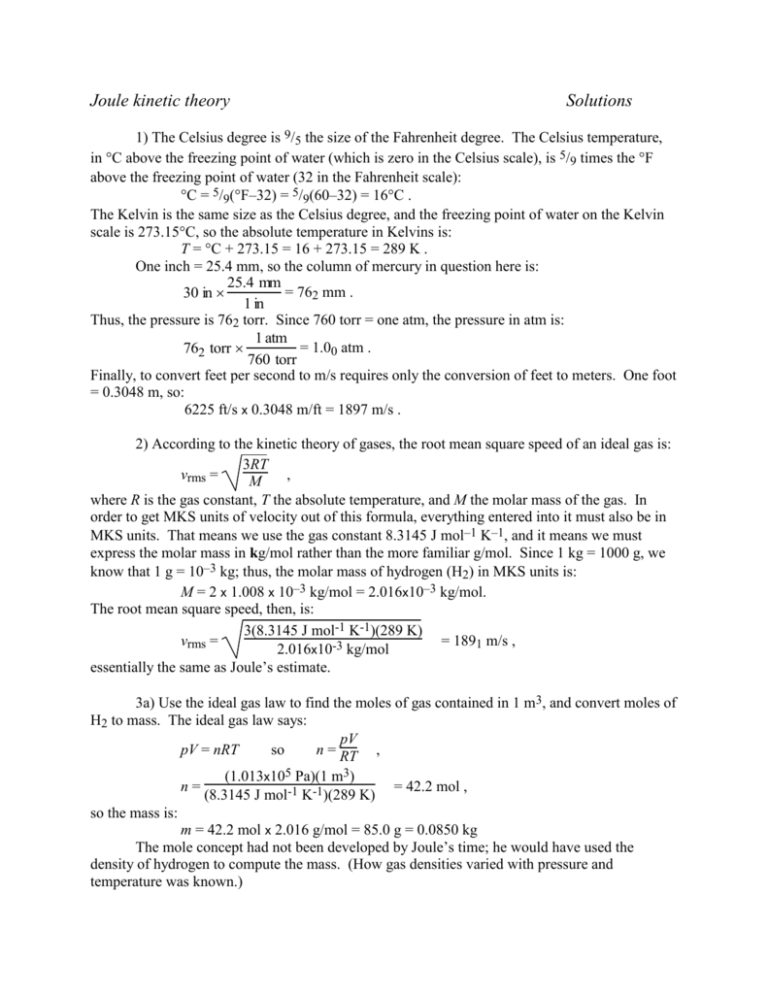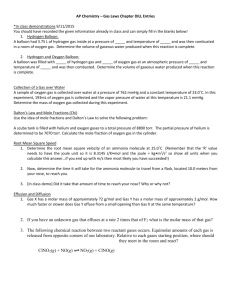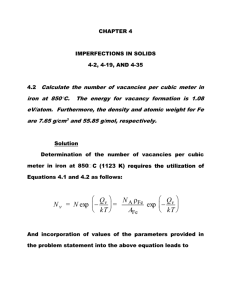joule - Le Moyne
advertisement

Joule kinetic theory Solutions 1) The Celsius degree is 9/5 the size of the Fahrenheit degree. The Celsius temperature, in °C above the freezing point of water (which is zero in the Celsius scale), is 5/9 times the °F above the freezing point of water (32 in the Fahrenheit scale): °C = 5/9(°F–32) = 5/9(60–32) = 16°C . The Kelvin is the same size as the Celsius degree, and the freezing point of water on the Kelvin scale is 273.15°C, so the absolute temperature in Kelvins is: T = °C + 273.15 = 16 + 273.15 = 289 K . One inch = 25.4 mm, so the column of mercury in question here is: 25.4 mm = 762 mm . 30 in 1 in Thus, the pressure is 762 torr. Since 760 torr = one atm, the pressure in atm is: 1 atm = 1.00 atm . 762 torr 760 torr Finally, to convert feet per second to m/s requires only the conversion of feet to meters. One foot = 0.3048 m, so: 6225 ft/s x 0.3048 m/ft = 1897 m/s . 2) According to the kinetic theory of gases, the root mean square speed of an ideal gas is: 3RT vrms = , M where R is the gas constant, T the absolute temperature, and M the molar mass of the gas. In order to get MKS units of velocity out of this formula, everything entered into it must also be in MKS units. That means we use the gas constant 8.3145 J mol–1 K–1, and it means we must express the molar mass in kg/mol rather than the more familiar g/mol. Since 1 kg = 1000 g, we know that 1 g = 10–3 kg; thus, the molar mass of hydrogen (H2) in MKS units is: M = 2 x 1.008 x 10–3 kg/mol = 2.016x10–3 kg/mol. The root mean square speed, then, is: 3(8.3145 J mol-1 K-1)(289 K) vrms = = 1891 m/s , 2.016x10-3 kg/mol essentially the same as Joule’s estimate. 3a) Use the ideal gas law to find the moles of gas contained in 1 m3, and convert moles of H2 to mass. The ideal gas law says: pV pV = nRT so n = RT , (1.013x105 Pa)(1 m3) n= = 42.2 mol , (8.3145 J mol-1 K-1)(289 K) so the mass is: m = 42.2 mol x 2.016 g/mol = 85.0 g = 0.0850 kg The mole concept had not been developed by Joule’s time; he would have used the density of hydrogen to compute the mass. (How gas densities varied with pressure and temperature was known.) b) The equation to be solved is: mv2 = F so v = F/m . 1 Recall that m is /3 the mass of the gas sample, so m = (0.0850 kg)/3 = 0.0283 kg, so v= 1.013x105/0.0283 m/s = 1.89x103 m/s . 4a) The calculation is similar to that in (3a), but with a volume of 1 ft3. Since 1 ft = 0.3048 m, we have: 1 ft3 = 1 ft3 x (0.3048 m/ft)3 = 0.0283 m3 , pV (1.013x105 Pa)(0.0283 m3) so n = RT = = 1.19 mol , (8.3145 J mol-1 K-1)(289 K) and m = 1.19 mol x 2.016 g/mol = 2.41 g . Joule reported the mass in grains, not grams: m = 2.41 g x 15.43 grain/g = 37.1 grains . Dividing this by three yields 12.4 grains . b) The force on a wall of Joule’s 1-ft cube would be the pressure times the area: F = (1.013x105 Pa)(1 ft)2 = (1.013x105 N m–2)(0.3048 m)2 = 9.41x103 N . When Joule says that the pressure on a wall of his cube is so many grains, he means that the force on a wall is equal to the weight produced by such a mass. We have computed the force; to get the corresponding mass, it is necessary to divide by the acceleration due to gravity: F = Ma = Mg so M = F/g = (9.41x103 kg m s–2)/(9.80 m s–2) = 960 kg . Converting to grains: M = 960x103 g x 15.43 grains/g = 1.48x107 grains . c) Finally, Joule set up his estimate of the velocity as a proportion. He argued that the force exerted by his hypothetical 12.3-grain particles would be 32 1/6 times their weight if they moved at the hypothetical speed of 32 1/6 ft/s . The force is proportional to the square of the speed, so if the true force (due to atmospheric pressure) is greater than this hypothetical force by a certain factor, then the true speed is greater than the hypothetical speed by the square root of that factor: vtrue2 Fatmos Fatmos = so v = v x true hypo Fhypo Fhypo . vhypo2 Note: In addition to the usage of pressure and force, Joule uses weight in places where we would use mass. He is also rather less careful with units and significant figures than we would want our students to be.







